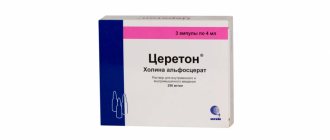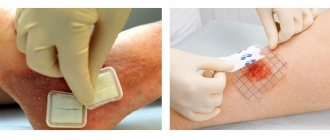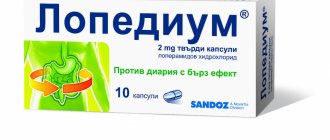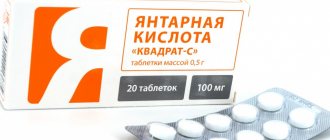Pharmacological properties of the drug Nexium tablets
Esomeprazole is the S-isomer of omeprazole. Inhibits the secretion of gastric juice due to specific inhibition of the proton pump of parietal cells of the gastric mucosa. The R- and S-isomers of omeprazole have the same pharmacodynamic properties. Esomeprazole is a weak base, accumulates and becomes active in the acidic environment of the secretory tubules of parietal cells, where it inhibits the enzyme H+K+-ATPase (proton pump), blocking the secretion of hydrochloric acid. After oral administration of the drug at a dose of 20–40 mg, the effect develops within 1 hour. When repeated administration of esomeprazole at a dose of 20 mg once a day for 5 days, the maximum value of gastric secretion stimulated by pentagastrin decreases by an average of 90% after 6–7 hours after taking it on the 5th day. 5 days after taking esomeprazole at a dose of 20 or 40 mg, the gastric pH value in patients with reflux esophagitis remained at level 4 for an average of 13 and 17 hours, respectively, and more than 24 hours in patients with symptomatic reflux esophagitis. The number of patients whose gastric pH remained at 4 for 8, 12 and 16 hours after taking esomeprazole at a dose of 20 mg was 76, 54 and 24%, respectively, and when taking a dose of 40 mg - 97, 92 and 56 %. A pronounced clinical effect of esomeprazole at a dose of 40 mg in the treatment of reflux esophagitis after 4 weeks of treatment is observed in 70% of patients, and after 8 weeks of treatment - in 93%. The use of esomeprazole at a dose of 20 mg 2 times a day for 1 week in combination with appropriate antibiotics ensures successful eradication of Helicobacter pylori in approximately 90% of cases. After a week's use of the drug in a complex eradication regimen, there was no need for further antisecretory monotherapy for complete scarring of an uncomplicated duodenal ulcer and elimination of its symptoms. In a randomized, double-blind, placebo-controlled clinical trial, 764 patients with endoscopically confirmed peptic ulcer bleeding were randomized to receive Nexium infusion (n=375) or placebo (n=389). After endoscopic hemostasis, patients received either 80 mg esomeprazole as an IV infusion over 30 minutes followed by a continuous infusion at a dose of 8 mg/hour, or placebo for 72 hours. After an initial period of 72 hours, all patients received Nexium 40 mg orally - 27 days to suppress the acid-producing function of the stomach. The rate of rebleeding within 3 days was 5.9% in the IV Nexium group compared with 10.3% in the placebo group (p=0.0256). On the 7th and 30th days after treatment, the incidence of rebleeding in the group receiving Nexium, compared with the group receiving placebo, was 7.2 versus 12.9% (p = 0.0096) and 7.7 versus 13.6%, respectively (p=0.0092). During the period of antisecretory therapy, the concentration of gastrin in the blood plasma increases in response to a decrease in acid secretion. The increase in the number of endocrine histamine-producing cells, which was noted in some patients with long-term use of esomeprazole, may be due to an increase in the level of gastrin in the blood plasma. Several cases of increased incidence of gastric granular cysts have been reported with long-term use of antisecretory drugs. These phenomena are a physiological consequence of prolonged inhibition of the secretion of hydrochloric acid of a benign and reversible nature. Nexium, compared to ranitidine, is more effective in the treatment of gastric ulcers caused by the use of NSAIDs, including selective COX-2 inhibitors. The drug is also effective for the prevention of peptic ulcers of the stomach and duodenum in patients receiving NSAIDs (over 60 years of age and/or with a history of peptic ulcers). Esomeprazole is acid-labile and is administered orally in the form of enteric-coated granules. Conversion to the R-isomer in vivo is negligible. Esomeprazole is rapidly absorbed from the intestine, with maximum plasma concentrations achieved approximately 1–2 hours after oral administration. Absolute bioavailability after a single oral dose of 40 mg is 64% and increases to 89% with repeated doses; when used at a dose of 20 mg, it is 50 and 68%, respectively. The volume of distribution in healthy volunteers at steady state is 0.22 l/kg. About 97% of esomeprazole is bound to plasma proteins. Concomitant food intake slows down and reduces the absorption of esomeprazole, but this does not reduce the antisecretory effect of the drug. Esomeprazole is completely metabolized with the participation of the cytochrome P450 system. The main part of esomeprazole is metabolized with the participation of the polymorphic enzyme CYP 2C19, responsible for the formation of hydroxy- and desmethyl metabolites of esomeprazole, the rest is metabolized with the participation of the second isoform of the enzyme CYP 3A4, responsible for the formation of esomeprazole sulfone, the main metabolite of esomeprazole detected in blood plasma. The parameters given below primarily reflect the pharmacokinetics in individuals who extensively metabolize esomeprazole via the CYP 2C19 enzyme. The total clearance is about 17 l/h after a single dose and about 9 l/h after repeated use. The half-life is about 1.3 hours after repeated dosing of the drug once a day. The pharmacokinetics of esomeprazole were studied in doses up to 40 mg 2 times a day. The AUC value increases nonlinearly in a dose-dependent manner with repeated administration of esomeprazole. This time-dependent dose dependence is explained by a decrease in first-pass metabolism and systemic clearance due to inhibition of the CYP2C19 enzyme by esomeprazole or its sulfometabolite. Esomeprazole is completely eliminated from the blood plasma during the interdose period without a tendency to accumulate in the body when taking the drug once a day. The main metabolites of esomeprazole do not affect gastric secretion. About 80% of esomeprazole is excreted in the form of metabolites in the urine, the rest in the feces. Less than 1% is excreted unchanged in urine. Special groups of patients. Approximately 1–2% of patients have low CYP2C19 enzyme activity (so-called poor metabolizers). In these individuals, esomeprazole is metabolized primarily by CYP 3A4. When repeated dosing of esomeprazole 40 mg once daily, the mean AUC value in poor metabolizers is approximately 100% greater than in individuals with high CYP2C19 enzyme activity (extensive metabolizers); the maximum concentration in blood plasma increases by approximately 60%. This fact does not require changing the dose of the drug. The metabolism of esomeprazole does not change significantly in elderly patients (from 71 to 80 years). After a single dose of 40 mg esomeprazole, the average AUC in women is 30% greater than in men. No gender-related differences were noted during repeated appointments. This fact does not require dose adjustment of esomeprazole. The metabolism of esomeprazole in patients with mild to moderate hepatic impairment may not be affected. The metabolic rate is reduced in patients with severe liver dysfunction, which leads to a 2-fold increase in AUC, so the maximum dose of the drug for such patients should not exceed 20 mg/day. There was no tendency for accumulation of esomeprazole and its metabolites when taking the drug once a day. Studies have not been conducted in patients with impaired renal function. Since metabolites of esomeprazole, rather than the parent compound, are excreted by the kidneys, changes in the metabolism of the drug should not be expected in patients with impaired renal function. Adolescent patients After repeated administration of 20 and 40 mg esomeprazole, the overall effect and time to maximum plasma concentrations in adolescents aged 12–18 years were the same as in adults.
Composition and form of the product
Nexium is produced in the form of tablets, extended-release capsules or lyophilisate in vials. The active substance in it is esomeprazole. Its content in various forms of the drug is:
- In tablets - 20 or 40 mg.
- In capsules - 10 mg.
- In bottles with lyophilisate – 40 mg.
Other auxiliary components that were used in the manufacture of the products are indicated in the manufacturer's instructions.
Indications for use of the drug Nexium tablets
Gastroesophageal reflux disease (GERD):
- treatment of erosive reflux esophagitis;
- long-term anti-relapse therapy of reflux esophagitis in cured patients;
- symptomatic treatment of GERD.
Combined with antibacterial agents for Helicobacter pylori eradication:
- treatment of duodenal ulcer associated with Helicobacter pylori ;
- prevention of relapses of peptic ulcers in patients with ulcers associated with Helicobacter pylori.
Treatment and prevention of ulcerative process caused by long-term use of NSAIDs:
- treatment of ulcerative processes caused by NSAID therapy;
- prevention of the development of peptic ulcers of the stomach and duodenum in patients at risk due to the use of NSAIDs.
Maintaining hemostasis and preventing the development of re-bleeding from gastric or duodenal ulcers after infusion therapy with Nexium. Treatment of Zollinger-Ellison syndrome.
Use of the drug Nexium tablets
Nexium tablets should be swallowed whole with plenty of liquid; the tablets should not be crushed or chewed. For patients who cannot swallow the tablet, it is recommended to dissolve it in 100 ml of still water. Other liquids should not be used as they may damage the enteric coating. The resulting liquid should be taken immediately or within 30 minutes. Then take another glass of water, rinse the walls with water and drink. Microgranules should not be chewed or crushed. For patients with difficulty swallowing, the tablet can be administered through a nasogastric tube after placing it in 1/2 glass of still water. It is very important that the syringe and probe are of the appropriate size. Administration of the drug through a nasogastric tube
- Place the tablet in the appropriate syringe and fill it with approximately 25 ml of water and 5 ml of air. Some probes may require 50 ml of water to prevent the tablet from obstructing the passage of the probe.
- Shake the syringe for 2 minutes until the tablet dissolves.
- Holding the syringe vertically (tip up), check the patency of the tip.
- Attach the syringe to the probe, holding it vertically.
- Shake the syringe and turn it upside down. Quickly inject 5–10 ml of liquid. Invert the syringe after injection and shake again (the syringe should be held vertically to prevent clogging of the tip).
- Turn the syringe over and inject another 5–10 ml of liquid into the probe. Repeat the procedure until all the liquid has been administered.
- To wash off the remaining drug from the walls of the syringe, fill it with 25 ml of water and 5 ml of air, shake, turn over and quickly inject the liquid. Some probes may require 50 ml of water.
Adults and children over 12 years of age Reflux esophagitis with GERD Treatment of erosive reflux esophagitis with GERD: 40 mg 1 time per day for 4 weeks. If symptoms of esophagitis persist, it is recommended to continue treatment for another 4 weeks. Anti-relapse treatment: 20 mg 1 time per day. Symptomatic treatment of GERD: 20 mg 1 time per day daily for 4 weeks in the absence of symptoms of esophagitis. If symptoms persist, re-examination is necessary. After eliminating the symptoms of the disease, further control is achieved by taking the drug at a dose of 20 mg 1 time per day. In adults, you can use the “on demand” regimen: 20 mg 1 time per day. In patients at risk of developing gastric or duodenal ulcers after taking NSAIDs, further symptom control using an on-demand regimen is not recommended. Adults In a complex regimen combined with antibacterial agents for the eradication of Helicobacter pylori Treatment of duodenal ulcers associated with Helicobacter pylori: 20 mg of Nexium with 1 g of amoxicillin and 500 mg of clarithromycin 2 times a day for 7 days. Anti-relapse treatment in patients with peptic ulcers caused by Helicobacter rulori: 20 mg of Nexium with 1 g of amoxicillin and 500 mg of clarithromycin 2 times a day for 7 days. Patients requiring long-term treatment with NSAIDs Treatment of peptic ulcers of the stomach caused by the use of NSAIDs: the recommended dose is 20 mg 1 time per day, duration of treatment is 4-8 weeks. Prevention of the development of peptic ulcers of the stomach and duodenum caused by NSAIDs in patients at risk: the recommended dose is 20 mg 1 time per day. Maintaining hemostasis and preventing the development of recurrent bleeding from a gastric or duodenal ulcer after treatment with Nexium (infusion solution): 40 mg 1 time per day for 4 weeks. The period of prescribing Nexium for oral administration should be preceded by infusion therapy with Nexium in the form of an infusion for 30 minutes, followed by intravenous infusion at a dose of 8 mg/hour for 3 days (72 hours). Treatment of Zollinger-Ellison syndrome: 40 mg 2 times a day. The dose should be selected individually, the duration of treatment is determined according to clinical indications. According to the clinical data obtained, disease control can be achieved in most patients when taking 80 and 160 mg of esomeprazole per day. If the dose exceeds 80 mg/day, it should be divided into 2 doses.
Action of the medicine
The action of zomeprazole is aimed at inhibiting the production of hydrochloric acid by the glands of the digestive organ. After taking Nexium tablets, the pH level of the stomach is quickly normalized. In this case, the indicators are maintained for 3–17 hours. In the future, a cumulative effect is ensured.
By providing a sustainable decrease in acidity, the medicine creates optimal conditions for the destruction of the bacterium Helicobacter pylori, which provokes the development of gastritis and peptic ulcers. In combination with antibiotics Nexium, the instructions focus on this, it allows you to destroy the pathogenic microorganism in almost a week. Patients with reflux esophagitis can get rid of unpleasant symptoms after a 4-week course of treatment. When using the drug, the risks of relapses and complications are significantly reduced.
Side effects of the drug Nexium tablets
Classified depending on the frequency of development: common (1/100, but ≤1/10), uncommon (1/1000, but ≤1/100), rare (1/10,000, but ≤1/1000) and very rare ( ≤1/10,000). From the hematopoietic system: rarely - leukopenia, thrombocytopenia; very rarely - agranulocytosis and pancytopenia. From the immune system: rarely - hypersensitivity reactions in the form of angioedema and anaphylactic shock, fever. From the side of metabolism: infrequently - peripheral edema; rarely - hyponatremia. From the mental side: infrequently - insomnia; rarely - agitation, depression, confusion; very rarely - aggression, hallucinations. From the side of the central nervous system: often - headache; infrequently - weakness, paresthesia, drowsiness; rarely - taste disturbance. From the organ of vision: rarely - blurred vision. On the part of the hearing organ: infrequently - dizziness. From the respiratory system: rarely - bronchospasm. From the gastrointestinal tract: often - abdominal pain, constipation, diarrhea, bloating, nausea, vomiting; uncommon - dry mouth; rarely - stomatitis, candidiasis of the digestive tract. From the hepatobiliary system: infrequently - increased activity of liver enzymes; rarely - hepatitis with and without jaundice; very rarely - liver failure, encephalopathy in patients with liver disease. From the skin: infrequently - dermatitis, itching, rash; rarely - alopecia, photosensitivity; very rarely - erythema multiforme, Stevens-Johnson syndrome, toxic epidermal necrolysis. From the musculoskeletal system: rarely - arthralgia, myalgia; very rarely - muscle weakness. From the kidneys and urinary system: very rarely - interstitial nephritis. From the endocrine system: very rarely - gynecomastia. Others: rarely - weakness, increased sweating.
Negative effects and overdose
The active substance is well tolerated. Therefore, negative reactions of the body rarely occur when using the drug for the prevention and treatment of various diseases. The following symptoms indicate drug intolerance:
- Dry mouth.
- Increased body temperature.
- Bronchial spasm.
- Swelling.
- Hyperhidrosis.
Sometimes Nexium can provoke disturbances in the functioning of the central nervous system: depression, drowsiness, dizziness. In severe cases, increased excitability and hallucinations may occur.
There are certain risks of disruptions in the gastrointestinal tract, disorders of the liver and problems with hematopoietic processes.
In case of an overdose, which can be caused by an amount of active substance exceeding 280 mg, severe weakness and negative effects on the digestive system occur. There is no specific antidote. Therefore, all that is needed is to refuse treatment with the drug and carry out symptomatic treatment. Dialysis is ineffective.
Special instructions for the use of Nexium tablets
In the case of a pronounced decrease in body weight, the appearance of nausea, dysphagia, hematemesis or melena with a diagnosed or suspected gastric ulcer, it is necessary to exclude the malignant nature of the disease, since the use of Nexium can smooth out symptoms and lead to untimely diagnosis of the tumor. Patients taking the drug for a long period (especially more than a year) should be under regular medical supervision. Patients taking the drug in an on-demand regimen should inform their doctor of any changes in symptoms of the disease. When prescribing, it is necessary to take into account the interaction of esomeprazole with other drugs that affect its concentration in the blood plasma. When prescribing esomeprazole for the purpose of Helicobacter rulori , it is necessary to take into account the possibility of drug interactions between all components of triple therapy. Clarithromycin is a potent CYP3A4 inhibitor, so its contraindications and interactions should be taken into account (in the case of triple therapy in patients taking other drugs metabolized by CYP3A4, such as cisapride, concomitantly with esomeprazole). The drug should not be prescribed to patients with hereditary fructose intolerance, insufficient absorption of glucose-galactose or sucrose-isomaltose deficiency. Impaired renal function No dosage adjustment is required in patients with moderately severe renal impairment. Due to the lack of experience with the use of Nexium in patients with severe renal failure, the drug should be prescribed to such patients with caution. Liver dysfunction No dose adjustment is required in patients with moderately severe liver dysfunction. In patients with severe liver failure, the maximum dose of Nexium should not exceed 20 mg/day. Elderly patients No dose adjustment is required in elderly patients. Children under 12 years of age Nexium should not be administered to children under 12 years of age as there are no data on use in this age group. Pregnancy and lactation: Clinical data on the use of Nexium in pregnant women is limited. The experiments did not establish the presence of embryotoxic and teratogenic effects in the drug, its direct negative or indirect effects on pregnancy, childbirth or postnatal development. However, the drug should be prescribed with caution during pregnancy. It is not known whether esomeprazole passes into breast milk and should not be used during breastfeeding. Taking the drug does not have a negative effect on the ability to drive vehicles or operate potentially dangerous machinery.
Nexium price, where to buy
The price of Nexium 40 mg tablets is about 450 rubles for 28 pieces.
The price of Nexium 20 mg is about 250 rubles for 28 pcs.
You can buy pellets and granules of the drug for about 1,700 rubles per 10 mg, 28 pieces.
- Online pharmacies in RussiaRussia
- Online pharmacies in UkraineUkraine
- Online pharmacies in KazakhstanKazakhstan
LuxPharma* special offer
- Nexium amp.
40 mg No. 10 RUR 15,900 order
ZdravCity
- Nexium tablets p.p.o. 40 mg 28 pcs AstraZeneca AB
430 rub. order
- Nexium tablets p.p.o. 20 mg 28 pcs AstraZeneca AB
RUB 245 order
- Nexium pellets p.p.o. and granules for Prig Susp. for internal approx. 10 mg 28 pcs AstraZeneca AB
RUB 1,724 order
Pharmacy Dialogue
- Nexium pellets and granules for the preparation of suspension 10 mg No. 28Astra Zenesa
RUB 1,697 order
- Nexium tablets 40 mg No. 28Astra Zenesa/AstraZeneca Industries
452 rub. order
- Nexium tablets 20 mg No. 28Astra Zenesa/AstraZeneca Industries
RUB 227 order
show more
Pharmacy24
- Nexium 20 mg No. 14 tablets Astra Zeneca AB, Sweden
458 UAH.order - Nexium 40 mg N14 tablets Astra Zeneca AB, Sweden
505 UAH order
- Nexium 20 mg No. 7 tablets Astra Zeneca AB, Sweden
215 UAH order
- Nexium 40 mg 10 powder for solution for infusion Astra Zeneca AB, Sweden
2250 UAH. order
PaniPharmacy
- Nexium bottle Nexium powder for solution for injection 40 mg No. 10 Sweden, AstraZeneca
2371 UAH. order
- Nexium tablets Nexium tablets 20 mg No. 7 Sweden, AstraZeneca
237 UAH order
- Nexium tablets Nexium tablets 40 mg No. 14 Sweden, AstraZeneca
566 UAH order
- Nexium tablets Nexium tablets 20 mg No. 14 Sweden, AstraZeneca
520 UAH. order
show more
Drug interactions Nexium tablets
Effect of esomeprazole on the pharmacokinetics of other drugs Reduced gastric acidity during treatment with esomeprazole can lead to increased or decreased absorption of other drugs, the mechanism of absorption of which depends on the acidity of the medium. With simultaneous use of esomeprazole (and other proton pump inhibitors or antacids), the absorption of ketoconazole and itraconazole is reduced. Esomeprazole is metabolized by CYP 2C19 and CYP 3A4 enzymes. The combined use of esomeprazole with other drugs in which CYP 2C19 is involved in the metabolism (diazepam, cytolopram, imipramine, clomipramine, phenytoin) may lead to an increase in the concentration of these drugs in the blood plasma and require a reduction in their dose. This must be taken into account, especially when prescribing esomeprazole according to indications. Concomitant use of 30 mg esomeprazole results in a 45% decrease in clearance of diazepam substrate. The combined use of 40 mg esomeprazole leads to an increase in plasma phenytoin levels by 13% in patients with epilepsy. It is recommended to monitor the concentration of phenytoin in the blood plasma when prescribing or discontinuing esomeprazole. When using Nexium and warfarin simultaneously, blood coagulation parameters should be monitored due to an increase in coagulation time. In healthy volunteers, co-administration of 40 mg esomeprazole with cisapride resulted in a 32% increase in AUC and a 31% increase in half-life, but no significant increase in the maximum plasma concentration of cisapride. A moderately prolonged QT on the ECG was observed after isolated administration of cisapride; subsequently, when cisapride was prescribed in combination with esomeprazole, the interval did not increase. When simultaneous administration of omeprazole (40 mg 1 time per day) with atazanavir (300 mg)/ritonavir (100 mg) in healthy volunteers, the concentration of atazanavir in the blood plasma significantly decreased (about 75% decrease in AUC, Cmax , Cmin ) . Increasing the atazanavir dose to 400 mg did not compensate for the effect of omeprazole on atazanavir concentrations. Proton pump inhibitors (including esomeprazole) should not be used in combination with atazanavir. Esomeprazole does not have a significant effect on the pharmacokinetics of amoxicillin or quinidine. With simultaneous short-term use of esomeprazole and naproxen or rofecoxib, no clinically significant interaction was detected. Effect of other drugs on the pharmacokinetics of esomeprazole When using esomeprazole and the CYP3A4 inhibitor clarithromycin (500 mg 2 times a day) simultaneously, an increase in the AUC of esomeprazole by 2 times was noted. The combined use of esomeprazole and voriconazole (a combined inhibitor of CYP 2C19 and CYP 3A4) may increase the exposure of esomeprazole by more than 2 times. In these cases, no dose adjustment of esomeprazole is required.
Nexium analogs
Level 4 ATC code matches:
Khairabesol
Noflux
Lancid
Barol
Beret
Ontime
Gastrozol
Omeprazole
Pantoprazole
Proxium
Lansoprazole
Zulbex
Ultop
Epicurus
Pariet
Losek MAPS
Losek
Sanpraz
Emanera
Omez Insta
What can replace the drug? In fact, synonyms for the drug are:
- Nexpro
- Exoxium
- Esonexa
- Esox
- Ezolong
The most common analogues:
- Esomealox
- Emanera
- Barol
- Esomeprazole
- Veloz
- Geerdin
- Control
- Ozol
- Omez
- Normicide
- Rabimak
- Panum
- Pariet
- Razol
- Ultop
The price of analogues may differ significantly from the original.
Which is better: Pariet or Nexium?
In general, the question of using this or that drug should be determined individually, depending on the test results and the body’s sensitivity to this or that drug. However, there is an opinion among experts that Pariet is somewhat more effective than Nexium. Its effect occurs faster, the daily dosage is smaller, and side effects occur less frequently. Both products are expensive, which is entirely justified by their effectiveness.










